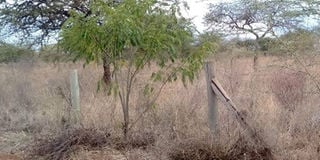Senna Siamea: A good moneymaker, but bad pig and chicken fodder

Siamese cassia. Like the acacia and croton, it is a multi-branched tree hence can be sustainably utilised for fuel and charcoal with only branches being harvested. PHOTO | FILE | NATION MEDIA GROUP
What you need to know:
- It struggles in waterlogged soils as this exposes it to root rot. This has been my experience growing this tree in Soy. Those that I planted on the part of the farm that is swampy eventually died.
- According to the Seed Handbook of Kenya (2nd edition) edited by Omondi, W, Maua, JO, and Gachathi, FN, soaking mimics the conditions under which the seeds germinate in their natural ecological zones. These trees, for example, grow in wet and humid regions.
- Michael Meso, a Kenya Forestry Research Institute seed scientist, says moisture levels play a big role in alerting seeds to optimal growth times.
- In the nursery, seeds may be sowed in containers, or nursery beds and trays and transplanted to containers after germination.
Senna Siamea, also known as Siamese cassia or Cassia siamea, is native to Asian countries of Thailand, Myanmar, Malaysia, India, Sri Lanka and Bangladesh. However, it has been cultivated worldwide and is naturalised in many countries.
It is an evergreen tree that can grow up to 20 metres tall with beautiful yellow flowers whose nectar and pollen are loved by bees.
In Thailand, it has also been used as medicine and its buds as a vegetable for 5,000 years. During preparation, the cooking liquid is replaced three times to remove toxins. In Sri Lanka, the flowers and young fruits are used in curries.
Medicine from the tree treats anxiety disorders, mild panic attacks and stress.
Useful trees and shrubs for Kenya, authored by Maundu, P. and Tengnas, B. (Eds) and published by World Agroforestry Centre says it does well in zones of 0-1,400 metres above sea level and annual rains of between 800-1,400mm.
It struggles in waterlogged soils as this exposes it to root rot. This has been my experience growing this tree in Soy. Those that I planted on the part of the farm that is swampy eventually died.
Propagation is through seedlings. And the seeds need pre-sowing preparation. This involves soaking them in hot water, which is left to cool for 12 hours.
According to the Seed Handbook of Kenya (2nd edition) edited by Omondi, W, Maua, JO, and Gachathi, FN, soaking mimics the conditions under which the seeds germinate in their natural ecological zones. These trees, for example, grow in wet and humid regions.
Over the years, the seeds develop defences to survive these conditions. These defences include hard coats and germination inhibitors that can only be softened or removed under induced conditions.
Soaking before planting, therefore, helps break down the seed’s natural defences against what it expects from nature, which then allows it to germinate faster.
Michael Meso, a Kenya Forestry Research Institute seed scientist, says moisture levels play a big role in alerting seeds to optimal growth times.
SUSTAINABLY UTILISED
By soaking the seeds, you quickly boost the moisture content around them, which signals that it is now safe to grow.
A kilogramme contains about 37,000-43,000 Cassia siamea seeds and germination is about 70 per cent.
Seeds should be sowed in well-prepared beds containing sandy soil and covered with light mulch of dry grass. Watering should be regularly (morning and evening). Seeds germinate within seven to 20 days.
In the nursery, seeds may be sowed in containers, or nursery beds and trays and transplanted to containers after germination.
Seedlings are kept in the nursery for 12-14 weeks or until they have attained a height of 25-30cm before being potted.
Senna siamea’s commercial value is in timber, charcoal, fuelwood, poles, fodder, bee forage, medicine and nitrogen-fixing. Its dense, dark-coloured wood makes good fuel, although it produces some smoke when burning. It was formerly preferred for locomotive engines. Like that of the acacia, its charcoal is of excellent quality.
The tree is also used in intercropping systems and windbreaks. It provides shade in cocoa, coffee and tea plantations.
It is useful for erosion control because of its root network.
The tree produces an extensive root system in the upper layer of the soil. In intercropping systems, the roots can aggressively compete with crops for nutrients and water if planted too close.
Senna siamea is widely grown for fodder. But chemicals in the leaves, flowers and seed pods are highly toxic to non-ruminants, such as pigs and poultry, and these animals should be kept away from its plantations.
If the end use objective is fuelwood, the tree can be harvested after five to seven years. The recommended spacing is one metre apart. For timber and charcoal, the trees have to grow bigger, thus, they need more room to expand hence they should be at least three metres apart.
The spacing can be as small as 25-30 inches if planted as a hedge or wind breaker. For mulch or leaf production, the first cut may be 12-18 months after sowing, followed by three to four harvests per year thereafter.
No significant pest or disease damage has been recorded, but minor damage can be caused by wood rot.
Like the acacia and croton, it is a multi-branched tree hence can be sustainably utilised for fuel and charcoal with only branches being harvested. And the branches that are cut regenerate for harvest in another four to seven years.




